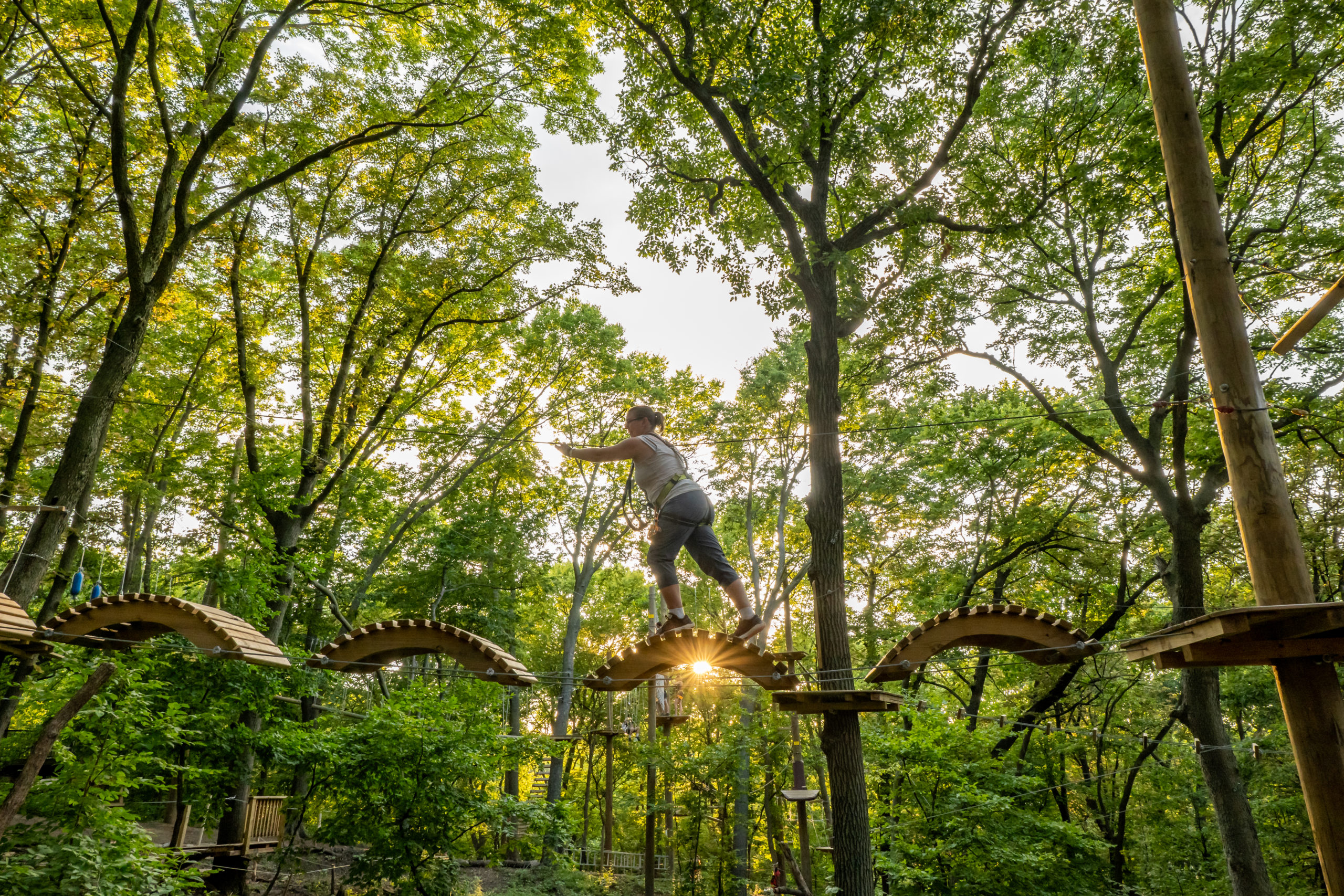
Venture on a History Hike: Get Outside
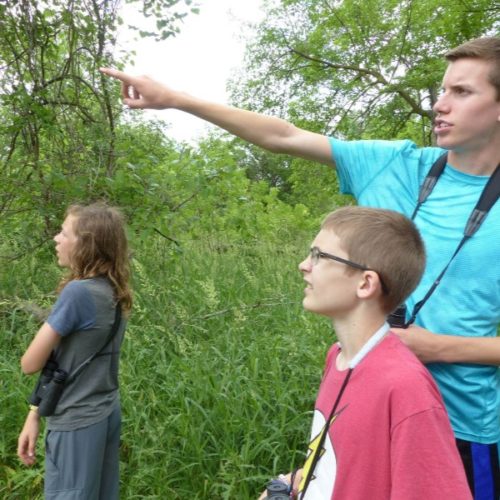
There’s nothing like a history hike at Fontenelle Forest to make weeks of dealing with the coronavirus pandemic seem just slightly longer than the blink of an eye. As an antidote to cabin fever, take this 3-mile walk to reset your perspective of time and to witness the arrival of spring.
Heidi Seals, an educator at Fontenelle Forest, recently described one of her favorite walks within the 1400+ acres of the nature center property, located just outside Omaha in Bellevue, NE. This hike takes 60 to 90 minutes and leads through three distinct habitats. While walking, you’ll also view the eons-old impact of natural forces on the environment, see lodging sites of ancient people, touch the bark of trees that sprouted before the birth of our country, and tread the path of early pioneers.
“There’s so much history there,” said Seals. And this is especially true if you add portions of the Mormon Hollow and Prairie trails to a trek on History Trail.
Where to start your History Hike
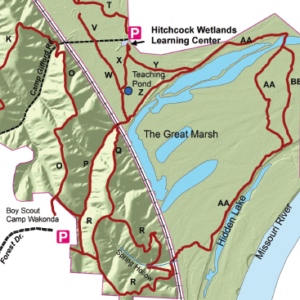
Park at Camp Wakonda and take Trail P – Mormon Hollow Trail – north. Turn right at Trail Q – Prairie Trail. At Trail R – History Trail – turn left. Follow the Trail R loop back to the parking lot. Click here for larger map.
To explore this area, park at Camp Wakonda. Once parked, find the trailhead for Mormon Hollow Trail and follow it north. Within minutes you’ll scramble down slopes into a shaded ravine with origins in the Glacial Period (between 11,500 and 120,000 years ago). Nowadays, tall trees line the top of the ravine and spring-fed streams trickle through it. The area is teeming with life. It’s easy now to spot the bowl-shaped fungus called Scarlet Cup or the fan of Turkey Tail fungus that grows in metallic bands varying from tan to blue. In this environment, you’ll hear woodpeckers and owls and you’ll see footprints of squirrels, turkey and deer in the mud. During a recent walk on this trail,Seals found the molar of what probably was a young deer. The tooth hadn’t been worn down by a lifetime of chewing
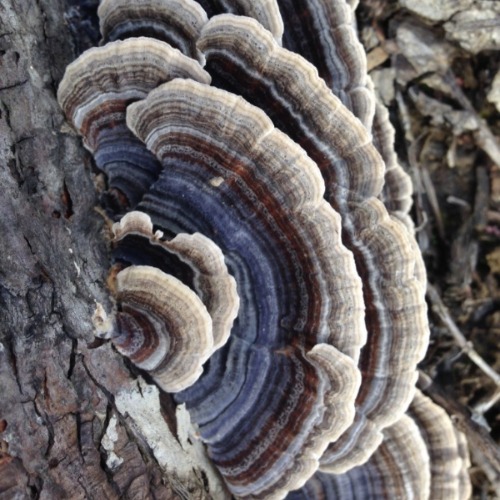
Turkey Tail Fungus
In addition to the tooth, Seals found a bottle she thinks dates to the 1800s. Back then, Mormon Hollow was part of the larger Mormon Trail. In the summer of 1846 and for several years after, more than 10,000 people took the Sarpy Ferry across the Missouri River to arrive at the base of this trail. Once on the Nebraska side of the water, pioneers pushed carts and led oxen through the ravine. A few travelers settled briefly in this area while others moved on toward what soon became the Utah Territory.
When hiking this area, Seals said, she likes to think about the fortitude demanded of people who passed through this ravine back then. She thinks about cartwheels bogged down in mud as people dug in their heels, leaned into the load and inched their way up the sides of the steep ravine.
See “new land” formed by a wandering river
As Seals passes out of the ravine and nears the Prairie Trail turnoff, she gazes across The Great Marsh toward the Missouri River and beyond to Iowa. She says it amazes her to think The Great Marsh was created over time as the Missouri River meandered and that the marsh did not exist in 1846. Back then, the Missouri River flowed just a stone’s throw away and the shores of Iowa were much closer.
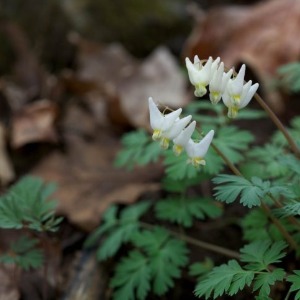
Dutchman’s Breeches
After looking at The Great Marsh, Seals turns right on Prairie Trail. She walks along the ridge of the ravine to her right, but flat grasslands spread out to the left. In this habitat, Seals watches tiny blue butterflies – called Spring Azures – flit around early spring wildflowers like Spring Beauties, which are white or pink with darker pink striations. Other flowers include the white and pink Dutchman’s Breeches.
“They’re the cutest thing ever,” Seals said. “They actually look like little tiny pants, upside down and hanging on a line.”
Seals said other wildflowers will bloom soon, including Crocus and Bloodroot. Bloodroot has large white flowers with a yellow center, and it grows in colonies that can fill a hillside. As a side note, the flowers close at night, and Native Americans used sap from the lower stems and roots of the plant to make dye. Wildflowers like these grow along the entire stretch of Prairie Trail, which ends at a “T” intersection with History Trail.
Explore the land of Pioneers and Ancient Peoples
The walk along History Trail, Seals said, passes several interesting sites. First, look out for the faint ruts of an old trading post road that runs to the left and parallel with the trail. The trading post road was used in the 1820s and 1830s by fur traders. One of these fur traders might have been Lucien Fontenelle, who came west from New Orleans and married Meumbane (or “Bright Sun” in English), the daughter of the Omaha Tribe’s Chief, Big Elk.
The couple had five children including Logan – who is Fontenelle Forest’s namesake. Logan, the eldest, grew up in two different worlds and spoke French, English and several Native American languages. When Logan was 16, an Indian Agent contracted him to be the interpreter for the Omaha Tribe in Washington, DC. Logan played an influential role within the tribe throughout his life and died at the age of 30 in the company of Omaha tribesmen. The group was hunting when they were attacked by a group of Oglala Sioux and Logan was killed. Logan – along with his father and possibly his mother – is buried at an unknown spot along History Trail. The burial site is near a marker erected on the trail in 1926 by the Daughters of the Revolution.
Wrap your arms around 300-year-old treeS
Soon after the grave marker, the history hike pass through the third habitat on this walking route. Crews from Fontenelle Forest are removing invasive species here to recreate the area’s original oak savannah. Sun through the branches of the Bur Oak and other giant trees – some of which were saplings in 1722. In addition to the Bur Oak,
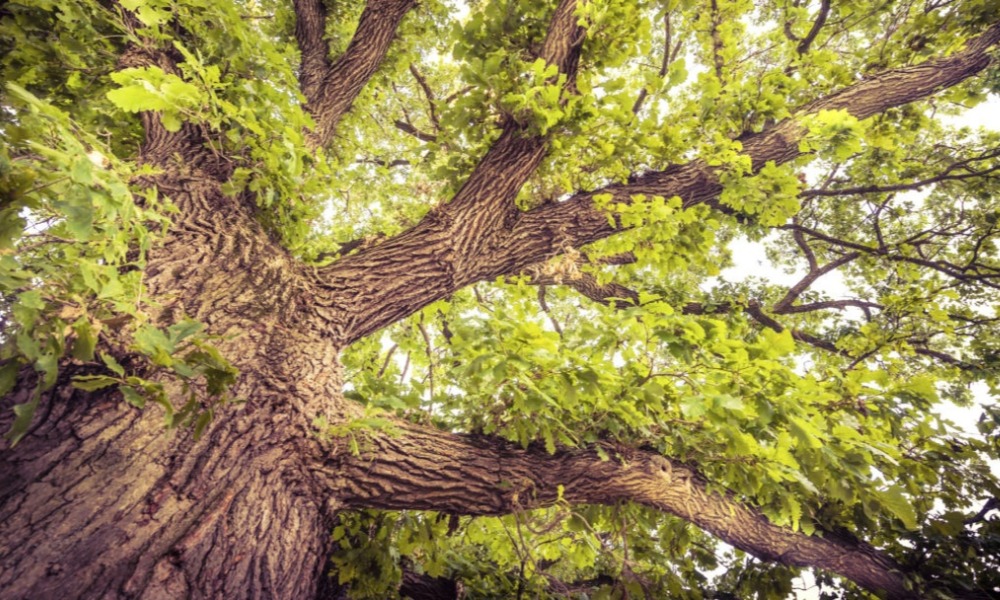
Bur Oak Tree
Seals suggested keeping a lookout for Honey Locust trees. These trees have a built-in defense system. Arm-length spikes protrude from the trunks of these trees. The trees also drop pods in the springtime, a special treat for deer.
While in this forest, look for large bowl-like depressions in the earth. These mark the lodging sites of people who lived here during the Nebraska Phase nearly 1,000 years ago. Archeologists have located more than 60 lodge sites within Fontenelle Forest. At these sites, they have found pottery fragments, flint projectile points and fishing hooks. They also have found bones of prey including deer and bison as well as charred corn kernels, indicating that these early people were hunters and farmers.
Ponder recent events on this history hike
From this area, Seals likes to look once more over The Great Marsh. This vantage point allows her to take in Hidden Lake and the environmental impact of a more recent historical event. Last year at this time, Missouri River floodwaters raged across The Great Marsh. It deposited rubble from upstream and unmoored shallow-rooted cottonwood trees. Even now, debris and water from that flood remains. This can remind us of the lasting impact of the powerful forces of nature. Yet, as we continue down History Trail, it also reminds us that nature is resilient and that our days of fretting as a result of the coronavirus will pass.
Fontenelle Forest trails remain open to members or with daily admission (although buildings are closed to the public). You can purchase a membership or daily admission and support the not-for-profit nature center’s mission by clicking here. In addition, you can find out more about hikes within the forest by visiting the Fontenelle Forest website. Staff members answer telephone inquiries at (402) 731-3140.
Check out other TreeRush blogs by clicking here.
Three Hikers photo – Iowa Young Birders
Turkey Tail Fungus photo- Half Hill Farm
Dutchman’s Breeches photo- Pixnio
Bur Oak from photo – Arbor Day Foundation
Written by Kema Geroux

